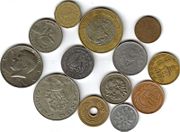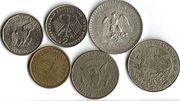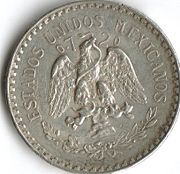Coin collecting
2008/9 Schools Wikipedia Selection. Related subjects: Recreation
 |
| Numismatics Terminology |
| Currency Circulating currencies
Fictional currencies |
Ancient currencies
Medieval currencies
|
Production
|
Exonumia
Notaphily Scripophily
|
Coin collecting is the collecting or trading of coins or other forms of legally minted currency. Frequently collected coins include those that were in circulation for only a brief time, minted with errors or especially beautiful or historically interesting pieces. Coin collecting can be differentiated from numismatics in that the latter is the study of currency, though both are obviously closely related.
History
While hoarding coins due to their value goes back to the beginning of coinage, collecting coins as pieces of art was a later development. Known as the "Hobby of Kings", modern coin collecting is generally believed to have begun in the fourteenth century with the Italian scholar and poet Petrarch. Numismatics reached its apex due to the great demand during the late Middle Ages and the early Renaissance. In this period ancient coins were collected by many European Kings, Princes, and nobility. Some of the great collectors were Pontif Boniface VIII, Emperor Maximilian of the Holy Roman Empire, Louis XIV of France, Ferdinand I, Elector Joachim II of Brandenburg who started the Berlin coin cabinet and Henry IV of France.
The first international convention for coin collectors was held August 15–18, 1962, in Detroit, Michigan and was sponsored by the American Numismatic Association and the Canadian Numismatic Association. Attendance was estimated at 40,000.
Specialties
Coin collectors often begin by saving coins they have received in circulation but found interesting. These may be the remnants of change from an international trip or an old coin found in circulation. Over time, if their interests increase, chance will not be sufficient to satisfy the demands for new specimens, and a potentially expensive hobby is born. Some become dedicated generalists, looking for a few examples of everything. If they have enough resources, this can result in an astounding collection, as that of King Farouk of Egypt, who collected everything (not just coins). Some are completists, wanting an example of everything within a certain set. For example, Louis Eliasberg was the only collector thus far to assemble a complete set of known coins of the United States.
Coin collecting can become a competitive activity, as evidenced recently by registry sets. Registry sets are sets of coins published by grading services. The grading services assess these sets by their completeness and by their numerical grade. This can lead to astronomical prices as dedicated collectors strive for the very best examples of each date and mint mark combination.
Most collectors determine that they must focus their financial resources on a narrower interest. Therefore, some collectors focus on coins of a certain nation or historic period, some collect coins from various nations and some settle on error coins. Still others might focus on exonumia such as currency, tokens or challenge coins.
Coin condition and value
In coin collecting the condition of a coin is paramount to its value; a high-quality example is often worth many times more than a poor example. Of course, this is true for nearly all other types of collectibles (such as stamps or trading cards). There are always exceptions to this generalization. Collectors have created systems to describe the overall condition of coins. One older system describes a coin as falling within a range from "poor" to "uncirculated". The newer Sheldon system, used primarily in the US, has been adopted by the American Numismatic Association. It uses a 1–70 numbering scale, where 70 represents a perfect specimen and 1 represents a barely identifiable coin.
Several coin grading services will grade and encapsulate coins in a labeled, air-tight plastic holder. This process is commonly known as coin slabbing and is most prevalent in the US market. Two highly respected grading services are the Numismatic Guaranty Corporation (NGC) and the Professional Coin Grading Service (PCGS). However, professional grading services are the subject of controversy because grading is subjective; coins may receive different grades by different services or even upon resubmission to the same service. Due to potentially large differences in value over slight differences in a coin's condition, some commercial coin dealers will repeatedly resubmit a coin to a grading service in the hope of a higher grade. The grading services came into being (PCGS being first) in an effort to bring more safety to investors in rare coins. While they have reduced the number of counterfeits foisted upon investors and have improved matters substantially, the goal of creating a sight-unseen market for coins remains somewhat elusive.
Damage of any sort (e.g. holes, edge dents, repairs, cleaning, re-engraving or gouges) can substantially reduce the value of a coin. Specimens are occasionally cleaned or polished in an attempt to pass them off as higher grades or as uncirculated strikes. Because of the substantially lower prices for cleaned or damaged coins, some specialize in their collection. There is a market for almost any rare or obsolete coin.
Common collection themes
A few themes are common and are often combined into a goal for a collection.
Country collections
Many collectors attempt to obtain an example from every country which has issued a coin. In contrast to those who collect coins from all countries, many collect coins from only one country, often their own.
Year collections
Rather than collecting one example of a type, some collectors prefer to collect by year, and thus collect one Lincoln cent for every year from 1909 to the present. This is probably one of the most practical ways to collect US currency. Most bookstores sell specially designed books for the purpose of collecting coins by year.
Mintmark collections
Many collectors consider that different mint marks give sufficient differentiation to justify separate representation in their collection. This increases the number of examples needed to complete a collection from one per year to several per year. Some mintmarks are more rare than others. This is what makes collecting different mintmarks exciting for collectors.
Variety collections
As mints issues many thousands or millions of any given coin, there are generally multiple sets of dies used. Occasionally these dies will be slightly different. Generally this is in a very small detail, such as the number of leaves on the ear of corn on the recent US Wisconsin state quarter. Varieties are more common on older coins, when the coin die were hand carved.
Type collections
Often a collection consists of an example of major design variants for a period of time in one country.
Subject collections
Collectors with an interest in a subject (e.g. ships or dogs) may collect only coins depicting that interest.
Composition collections
For some, the composition of the coin itself is interesting. For example there are a number of collectors of only bimetallic coins. Normally only precious metals like gold, silver and platinum fit this category.
Period collections
Many collectors restrict themselves to coins issued after the 18th or 19th century, while others collect ancient and medieval coins. Coins of Roman, Byzantine, Greek, Indian, Celtic, Parthian, Merovingian, Ostrogothic, and ancient Israelite origin are amongst the more popular ancient coins collected. Specialties tend to vary greatly, but some approaches include the collection of coins minted during a particular emperor's reign or a representative coin from each emperor. Coins are often a reflection of the events of the time in which they are produced, so coins issued during historically important periods are especially interesting to collectors.
Types of coin collectors
Investors
A common reason given for purchasing coins is as an investment. Coin prices can be cyclical and prices may drop for coins that are not in great long-term demand. In addition to demand, condition and rarity are also determinants in pricing. The age of a coin is not, per se, a significant factor.
Many of the reasons given for investing in coins are similar to those given for investing in stamps, precious metals or other commodities. As with most collectibles, a coin collection does not produce income until it is sold, and may even incur costs (e.g. for safe deposit box storage) in the interim.
While collecting for pleasure can make an enjoyable hobby, those entering the field primarily to profit are warned to study before buying. Certain companies, some of whom may advertise on television, in newspapers, or in popular magazines, are alleged to make outlandish claims about the present and future values of their wares. After learning the basics of the field it is often possible to make better purchases from reputable dealers.
Hoarders
Coin hoarders are similar to investors and collectors in the sense that they accumulate coins. However, they typically don't focus on one specific variety, rather they gather whatever coins they can and hold them. Searching change for silver is a way to start.
Inheritors
Someone who acquires coins (collection, hoard, investment) from another person. The inheritor does not necessarily know anything about numismatics, they just have the coins.


